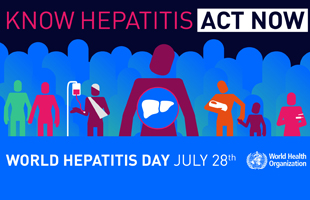
Baltazar Lucas, living with hepatitis B, survivor of liver cancer who went through a liver transplant. The painting reminds him of his three brothers who passed away of liver cancer.
Viral hepatitis is widely spread, affecting 400 million people worldwide – more than 10 times the number of people infected with HIV. The WHO Western Pacific Region bears a disproportionately high burden of hepatitis. Home to one quarter of the world’s population, the Region accounts for about 40% of hepatitis-related deaths worldwide – over 90% of these deaths from hepatitis B- or C-related liver cancer and cirrhosis.
Yet, hepatitis C is largely treatable, as more than 90% of people with hepatitis C can be cured with treatment. Vaccination is the main prevention method to control hepatitis B. Hepatitis D can be prevented through hepatitis B vaccination, since it is only transmitted to people infected with hepatitis B virus. Recent data revealed that hepatitis B vaccination across the Western Pacific Region has averted 7 million deaths and 37 million chronic infections that would have occurred among children born between 1990 and 2014. This signifies a tremendous public health achievement for the Region.
“Despite progress made in the Region, hepatitis still remains a concern,” said Dr Shin Young-soo, WHO Regional Director for the Western Pacific. “But we now have effective antivirals that can stop hepatitis B and even potentially reverse the progress of the disease. The vast majority of hepatitis C cases can now be cured in just three months. Unfortunately, treatment remains unaffordable and inaccessible for most in the Region.”
The vision of eliminating hepatitis as a public health threat by 2030 is attainable. In the Western Pacific Region, WHO assists Member States to fight viral hepatitis through supporting implementation of the WHO Regional Action Plan for Viral Hepatitis in the Western Pacific 2016–2020. The regional action plan provides a systematic approach to priority areas for action to reduce the impact of viral hepatitis.
Vaccines against hepatitis A and hepatitis E are also available. In 2011, the first vaccine to prevent hepatitis E infection was licensed in China. Although not yet available globally, it will likely become available in a number of other countries in the Region. There is currently no vaccine against hepatitis C virus.
WHO recommends that infants receive a dose of hepatitis B vaccine at birth, followed by at least two doses to complete the vaccine series that provides long-term protection. The vaccine is safe and effective. The hepatitis B vaccine should also be administered to high-risk groups and health workers.
World Hepatitis Day provides an opportunity to:
- continuously raise awareness of the high burden of viral hepatitis and to influence real change in disease prevention and access to testing, treatment and care;
- strengthen prevention, screening and control of viral hepatitis and related liver disease;
- encourage increased hepatitis B vaccine coverage and increased integration of the vaccine into national immunization programmes including a hepatitis B vaccine birth dose; and
- coordinate a global response to viral hepatitis.
Viral hepatitis is an infection resulting in liver impairment and is caused by one of the five hepatitis viruses: A, B, C, D and E. The five hepatitis viruses are transmitted through different routes: hepatitis A and E through contaminated food and water; hepatitis B through blood and other bodily fluids; hepatitis C and D mostly through blood. These viruses can all cause acute hepatitis. Most people fully recover from acute infection. However, hepatitis B and C infection can lead to chronic liver disease, which is the most common cause of liver cancer and cirrhosis, which can be fatal.




